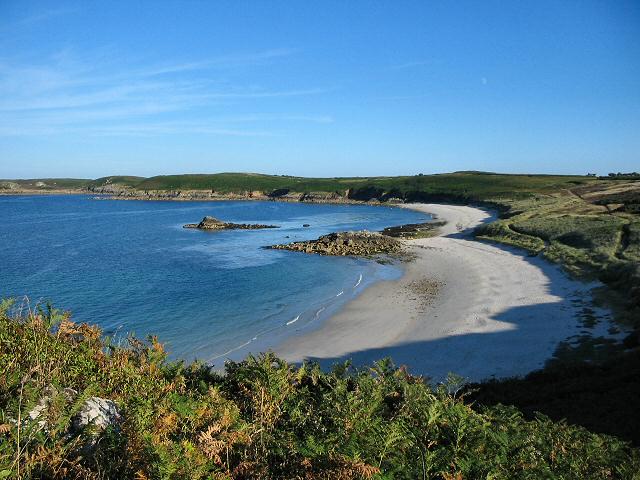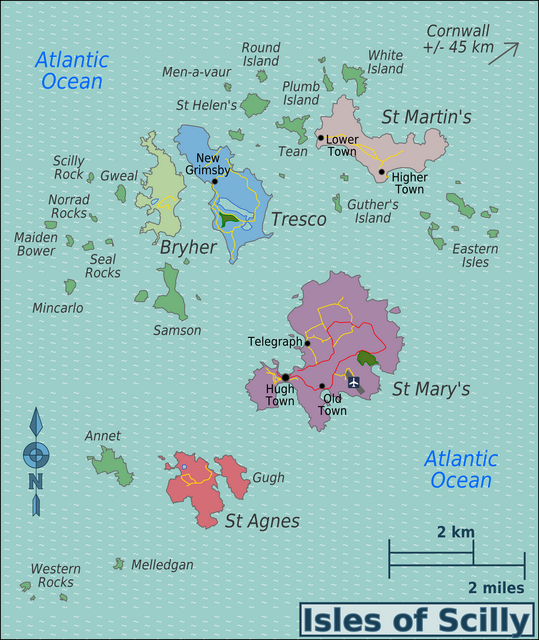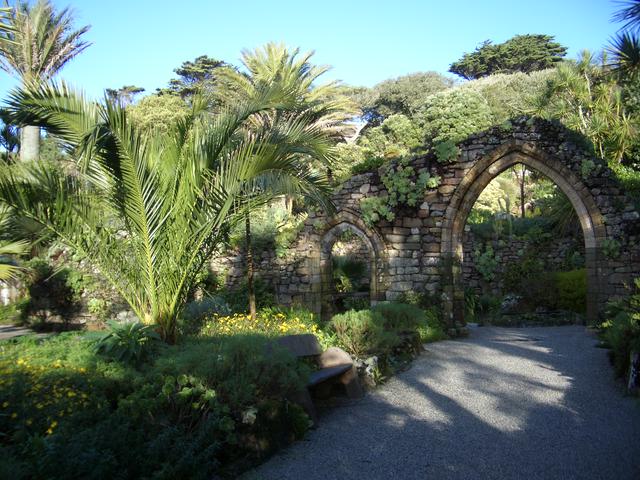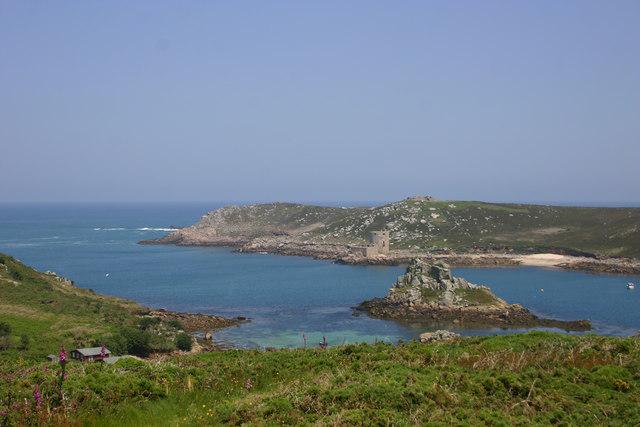
The Isles of Scilly (Cornish: Ynysek Syllan) is a small archipelago of islands in the Atlantic Ocean, off the coast of Cornwall at the south-west tip of the United Kingdom. The main island, and obvious base for visitors, is St Mary's. Four of the other islands (known as "Off Islands") are inhabited: best known is Tresco for its Abbey Gardens. All the islands are scenic, and collectively they've been designated an "Area of Outstanding Natural Beauty".
Look at a map of the islands or a satellite photo, and it's as if a single large island has drowned. And that is indeed what happened, possibly as recently as 500 AD, as "Ennor" sank to become a source for legends of Atlantis and Lyonesse. These islands are the last redoubt of land as Britain pokes its toe into the Atlantic, so they came to signify first & last sight of the homeland, or terrible shipwreck, or a nest of rebels and pirates, or first point of attack from overseas powers.
The islands bask in the Gulf Stream and are very mild and sunny. They're cooler than mainland England at the height of summer, but considerably warmer in winter, and frost is rare. This balmy climate fosters sub-tropical flora and a flower industry, plus tourism. St Mary's is the largest island with a population of around 1750, with Hugh Town the main settlement. The other four inhabited Off Islands are each home to a hundred or so. There's limited visitor accommodation and limited transport capacity, so book them simultaneously. The islands are frankly expensive (it's cheaper to holiday in the Med), so even with day-trippers they're not mobbed by tourist hordes - until a cruise ship appears, as they regularly do.
There are no slabby office blocks, high-rise flats or chain hotels here. Much of the land is owned by the Duchy of Cornwall (ie Prince of Wales), who together with the islands' Council are determined to preserve its character and wildlife. Minor royalty take holidays here, and you'll frequently spot the Duchy's coat of arms. It looks like a bunch of grapes but in heraldry it's "Sable, 15 bezants" plus other flummery. (Translation: black, with 15 gold coins of Byzantium, looted by Crusaders.)
Always, if a local is within earshot, refer to the place as "The Isles of Scilly", and don't be caught saying "The Scilly Isles" or "The Scillies". It's just one of those shibboleths, though you'll find plenty of counter-examples. An islander is called a "Scillonian", same as the ferry.
The official Tourist Information Centre is on Portcressa Rd in Hugh Town. There's also an independent travel agent Isles of Scilly Travel on Hugh Street.
There are five inhabited islands:

And a large number of smaller uninhabited islands and islets:

- Isles of Scilly Museum, Church Street, St Mary's TR21 0JT, +44 1720 422337. Easter-Sep M-F 10AM-4:30PM; Sa 10AM-noon; Oct-Good Friday M-Sa 10AM-noon. It's an ill wind: the gales of winter 1962 unearthed Romano-British remains, so where to house them? This museum, opened in 1967, displays the history of the islands. Pirates, longitude, wildlife, it's all here. Adults £3.50, concs £3, children 5-16 £1.
- Harry's Walls, St Mary's (East of town above Portmellon beach. Always open. These are the walls of an unfinished artillery fort built to the east of the harbour in 1552-53. Building was abandoned when they decided instead to fortify the headland to the west, which became The Garrison. Free.
- The Garrison. Always open. The Spanish Armada was defeated in 1588, but they might come back for revenge, so fortification began here (abandoning the less-well-sited Harry's Walls). Enter the curtain wall via the Gatehouse; the powder magazine here has a free exhibition on the history. A circuit along the walls is a pleasant one hour walk, past artillery emplacements and redoubts; mostly firm easy going but some rough spots. Imposing Hugh House was the officers' quarters. The core of the Garrison, a stout Vauban-style bastion, is now the Star Castle Hotel. Free.
- Bant's Cairn. Burial Chamber dates from the Bronze Age, as the gradual flooding of Ennor forced inhabitants onto higher ground. It was empty when first excavated in 1900. St Mary's has some 80 similar "entrance graves", e.g. at nearby Innisidgen and at Porth Hellick Down on the east tip, but Bant's Cairn is the finest. A little lower down the hill is Halangy Down Ancient Village, occupied from the Iron Age into Roman times, with a prehistoric terraced field system. The cairn and ancient village are at the north end of St Mary's, the bus runs to the top of Telegraph Rd. They're always open, free.
Isles of Scilly Museum, Church Street, St Mary's TR21 0JT, +44 1720 422337. Easter-Sep M-F 10AM-4:30PM; Sa 10AM-noon; Oct-Good Friday M-Sa 10AM-noon. It's an ill wind: the gales of winter 1962 unearthed Romano-British remains, so where to house them? This museum, opened in 1967, displays the history of the islands. Pirates, longitude, wildlife, it's all here. Adults £3.50, concs £3, children 5-16 £1.
Harry's Walls, St Mary's (East of town above Portmellon beach. Always open. These are the walls of an unfinished artillery fort built to the east of the harbour in 1552-53. Building was abandoned when they decided instead to fortify the headland to the west, which became The Garrison. Free.
The Garrison. Always open. The Spanish Armada was defeated in 1588, but they might come back for revenge, so fortification began here (abandoning the less-well-sited Harry's Walls). Enter the curtain wall via the Gatehouse; the powder magazine here has a free exhibition on the history. A circuit along the walls is a pleasant one hour walk, past artillery emplacements and redoubts; mostly firm easy going but some rough spots. Imposing Hugh House was the officers' quarters. The core of the Garrison, a stout Vauban-style bastion, is now the Star Castle Hotel. Free.
Bant's Cairn. Burial Chamber dates from the Bronze Age, as the gradual flooding of Ennor forced inhabitants onto higher ground. It was empty when first excavated in 1900. St Mary's has some 80 similar "entrance graves", e.g. at nearby Innisidgen and at Porth Hellick Down on the east tip, but Bant's Cairn is the finest. A little lower down the hill is Halangy Down Ancient Village, occupied from the Iron Age into Roman times, with a prehistoric terraced field system. The cairn and ancient village are at the north end of St Mary's, the bus runs to the top of Telegraph Rd. They're always open, free.
Remember that your boat pick-up point may not be the same as your landing! Depending on tides it will be either Cairn Near Point on the south tip of the island, or New Grimsby on the west coast looking across at Bryher. They're a 20-min walk apart.
- Abbey Gardens, Tresco TR24 0QQ (centre of the island, +44 1720 424108. Daily 10AM-4PM. Impressive botanical garden with a range of Mediterranean and sub-tropical plants growing healthily outdoors. Created in the 19th century in the ruins of a Benedictine Abbey, with tall hedges and landscaping as windbreaks. Includes "Valhalla", a collection of sailing ship figureheads. Adult £15, conc £13.50, 5-15 £5, under 5 free.
- Cromwell's Castle, Tresco (15 mins walk north of New Grimsby along the coastal path. During daylight hours. This coastal gun tower was built by Oliver Cromwell in 1651-1652 on a promontory to guard the anchorage between Bryher and Tresco. It is administered by English Heritage. Free.
- King Charles's Castle. During daylight hours. A ruined artillery fort, probably built circa 1550 in the reign of King Edward VI, but named for King Charles by the Royalists who held out against Cromwell in these islands (with a spot of piracy on the side). It was badly sited and not much use, so its masonry was used to build Cromwell's Castle nearby. free.
- The "Great Pool" just north of Abbey Gardens has bird hides.
Abbey Gardens, Tresco TR24 0QQ (centre of the island, +44 1720 424108. Daily 10AM-4PM. Impressive botanical garden with a range of Mediterranean and sub-tropical plants growing healthily outdoors. Created in the 19th century in the ruins of a Benedictine Abbey, with tall hedges and landscaping as windbreaks. Includes "Valhalla", a collection of sailing ship figureheads. Adult £15, conc £13.50, 5-15 £5, under 5 free.
Cromwell's Castle, Tresco (15 mins walk north of New Grimsby along the coastal path. During daylight hours. This coastal gun tower was built by Oliver Cromwell in 1651-1652 on a promontory to guard the anchorage between Bryher and Tresco. It is administered by English Heritage. Free.
King Charles's Castle. During daylight hours. A ruined artillery fort, probably built circa 1550 in the reign of King Edward VI, but named for King Charles by the Royalists who held out against Cromwell in these islands (with a spot of piracy on the side). It was badly sited and not much use, so its masonry was used to build Cromwell's Castle nearby. free.
A small island, mostly farmland, and the most westerly settlement in England (not Britain, as Scotland and Ulster reach further west). The usual landing quay is on the east side just below All Saints Church, but it gets very shallow at low tide. On the west coast the Atlantic waves crash onto Hell Bay, and the Great Pool is a brackish lagoon separated from the sea by a storm beach. There are a couple of cafes and B&Bs plus a campsite. Seen north of the quay, Fraggle Rock is also known as Hangman Island. The bodies of rebels and pirates were often hung up in cages, and Isles of Scilly had plenty of both, but there's no evidence that Fraggle Rock was used for this. At spring low tide it's possible to walk to the southern uninhabited island of Samson, and even to Tresco, but seek local advice before attempting this. There's no transport to other islets such as Gweal.
This is the most northerly of the Isles of Scilly. The usual landing quay is at Higher Town on its south side. This tiny "town" straggles west through Middle Town to, guess where, Lower Town, where the Hotel Quay is the landing point at low tide. St Martin's is surrounded by rugged coastline and unspoilt beaches, and crisscrossed by paths. It has a bakery, a cafe, a couple of pubs, a few B&Bs, and a vineyard (open Tu-Th 11AM-4PM). The bright red & white tower at the north-east corner of the island is a navigational day-mark, erected 1683, and visible from mainland Cornwall - it's not a lighthouse as it never had a light. At the north tip, a rocky causeway passable at low tide connects to White Island, which has Neolithic remains and Sites of Special Scientific Interest. Seek local advice on safe crossing times, as the waves and tides can really rip over the causeway. There's no transport to other nearby islets such as Tean.
This is most southerly populated spot in Britain, with Troy Town Farm being the most southerly habitation in the UK. The quay is on the east of the island, and just next to it is a pub & cafe, the Turk's Head. This, and another couple of small cafes further west, are only open in summer. There's no hotel, but a couple of places do B&B. In the centre of the island is the main settlement and a lighthouse built in 1680; it's no longer lit but serves as a day-mark for shipping. Close to the quay is the tidal island of Gugh, connected to St Agnes by a tombolo of shingle and sand. Check times with the boatman, but you can usually walk across and stroll for a couple of hours either side of low tide. At these times St Agnes has a slightly larger area and population than Bryher; then the tide isolates Gugh and its three residents, and St Agnes again becomes the smallest of the Isles of Scilly.
- Boat trips: check the notice boards at Hugh Town quay or the St Mary's Boatmen's Association for what's available. On the Off Islands, check with the local boat company. See also "Get around" above for other options & practicalities.
- Pilot gigs are traditional Cornish six-oar rowing boats, slim and fast - the first boat to get a pilot out to a struggling ship won the job. They also acted as the first shore-based lifeboats, but since the 19th century have mostly been used for sport racing. Racing gigs must strictly adhere to the "Treffy" pattern of 1838; non-racing gigs may vary. The World Pilot Gig Championships are held here annually in May, with over 100 crews competing, and heroic partying afterwards. The next event is 3-5 May 2019, and there are practices and beer-races at other times. Boat trips follow them from St Mary's.
- Bird watching: the islands are important both for birds of passage - their first & last landfall, especially in spring and autumn - and for resident colonies, most active in early summer.
- Report a rat! St Agnes & Gugh and Annet are rat-free, the other islands are aiming to be. Ground-nesting birds such as the Manx Shearwater depend upon this. So report it if you think you see a rat, but don't try to whack it yourself. You'd only succeed if it was something else, like the Scillies Shrew, a protected species.
- Isles of Scilly Golf Club, Carn Morrval (The course is located on the north-east coast of St Mary's. is open all year and welcomes non-members. It's a nine-hole course, so 18-hole matches go round twice (5942 yards, par 73, record 66). The clubhouse serves food, drink and fine views; evening meals only summer Fri & Sat.
Boat trips: check the notice boards at Hugh Town quay or the St Mary's Boatmen's Association for what's available. On the Off Islands, check with the local boat company. See also "Get around" above for other options & practicalities.
Pilot gigs are traditional Cornish six-oar rowing boats, slim and fast - the first boat to get a pilot out to a struggling ship won the job. They also acted as the first shore-based lifeboats, but since the 19th century have mostly been used for sport racing. Racing gigs must strictly adhere to the "Treffy" pattern of 1838; non-racing gigs may vary. The World Pilot Gig Championships are held here annually in May, with over 100 crews competing, and heroic partying afterwards. The next event is 3-5 May 2019, and there are practices and beer-races at other times. Boat trips follow them from St Mary's.
Bird watching: the islands are important both for birds of passage - their first & last landfall, especially in spring and autumn - and for resident colonies, most active in early summer.
Report a rat! St Agnes & Gugh and Annet are rat-free, the other islands are aiming to be. Ground-nesting birds such as the Manx Shearwater depend upon this. So report it if you think you see a rat, but don't try to whack it yourself. You'd only succeed if it was something else, like the Scillies Shrew, a protected species.
Isles of Scilly Golf Club, Carn Morrval (The course is located on the north-east coast of St Mary's. is open all year and welcomes non-members. It's a nine-hole course, so 18-hole matches go round twice (5942 yards, par 73, record 66). The clubhouse serves food, drink and fine views; evening meals only summer Fri & Sat.
Lots of locally produced food and gifts are available. Beef, pork, lamb, duck, fresh fish and shellfish, wildflower honey, fudge, ice cream, paintings, pottery, glassware, jewellery and even soap, the list is endless. Each island has at least one stall selling locally produced fruit and veg together with fresh free range eggs. Scilly is famous for its flowers, and a wide variety of bulbs are available to take home.
There is a Co-op food store on St Mary's and some Off Islands have a well stocked shop.
The only two banks are in Hugh Town on St Mary's. Lloyds (M-F 9AM-4PM) has an ATM. At Barclays you need to go into the branch, open M Tu & Th 10AM-4PM, W 9AM-1PM. Many shops, pubs and post offices will do cash back.
For picnic supplies, stock up at the Co-op on St Mary's, or Off Island local shop. All the inhabited islands have decent pub and cafe food, and cream teas. Hours are geared to tourists and they have limited opening out of season.

- Cafe Kavorna (on Hugh Street beside Lloyd's Bank, +44 1720 422660) does good breakfasts, lunches and cream teas until 5 pm. Gluten-free and vegan options.
- Atlantic Inn, Hugh Town, St Mary's, +44 1720 422323. M-Sa 11AM-11PM, Su noon-10:30PM. Good pub serving notably decent food.
- Bishop and Wolf, Hugh Town, St Mary's TR21 0LL, +44 1720 422790. M-Sa 11AM-11PM, Su from noon. Good popular pub and eating place, serves St Austell Ales. It's named for the two infamous nearby rocks with lighthouses. The Wolf is midway between Cornwall and IOS - there's a fissure in it where strong winds make a howling noise. The Bishop way out to the west is the very last scrap of land of the UK; it may once have looked like a bishop's mitre but no-one really knows.
- Mermaid, Hugh Town, St Mary's (In former bank, next to quay, +44 1720 422701. Every traditional British coastal town has a pub which looks fit to be the haunt of crusty old sea dogs, with nautical decorations that look unchanged for the past 50 years. This is the one on Scilly. Do not expect any frills! The Ales of Scilly brands are very popular.
- Scillonian Club, The Parade, Hugh Town, St Mary's, +44 1720 422720. M-Sa noon-11PM, Su noon-10:30PM. Nice view over the bay, Skinner's Ale on tap, and a popular Sunday carvery (Su noon-2PM & 6-8:30PM, booking advised).
- Old Town Inn, Old Town, St Mary's, +44 1720 422301. Daily 11PM-midnight. The only pub on St Mary's away from Hugh Town.
Cafe Kavorna (on Hugh Street beside Lloyd's Bank, +44 1720 422660) does good breakfasts, lunches and cream teas until 5 pm. Gluten-free and vegan options.
Atlantic Inn, Hugh Town, St Mary's, +44 1720 422323. M-Sa 11AM-11PM, Su noon-10:30PM. Good pub serving notably decent food.
Bishop and Wolf, Hugh Town, St Mary's TR21 0LL, +44 1720 422790. M-Sa 11AM-11PM, Su from noon. Good popular pub and eating place, serves St Austell Ales. It's named for the two infamous nearby rocks with lighthouses. The Wolf is midway between Cornwall and IOS - there's a fissure in it where strong winds make a howling noise. The Bishop way out to the west is the very last scrap of land of the UK; it may once have looked like a bishop's mitre but no-one really knows.
Mermaid, Hugh Town, St Mary's (In former bank, next to quay, +44 1720 422701. Every traditional British coastal town has a pub which looks fit to be the haunt of crusty old sea dogs, with nautical decorations that look unchanged for the past 50 years. This is the one on Scilly. Do not expect any frills! The Ales of Scilly brands are very popular.
Scillonian Club, The Parade, Hugh Town, St Mary's, +44 1720 422720. M-Sa noon-11PM, Su noon-10:30PM. Nice view over the bay, Skinner's Ale on tap, and a popular Sunday carvery (Su noon-2PM & 6-8:30PM, booking advised).
Old Town Inn, Old Town, St Mary's, +44 1720 422301. Daily 11PM-midnight. The only pub on St Mary's away from Hugh Town.
- New Inn, New Grimsby, Tresco TR24 0QQ (just above the quay, +44 1720 422844. Always stock a good range of real ales. In 19th-century row of cottages, with rooms B&B.
- Fraggle Rock Bar, Bryher TR23 0PR, +44 1720 422222. Food daily except Su evening. Close to the campsite and noted for the Friday night fish and chips (plus Monday in summer) and double-decker crab sandwiches. Serves Proper Job and Doom Bar Bitter. 3 self-catering units available here. Fraggle Rock is the islet in the channel here, looking north to Cromwell's Castle on Tresco.
- Seven Stones Inn, Lower Town, St Martin's TR25 0QW (west end of island, +44 1720 423560. Good range of real ales.
- Turk's Head, St Agnes (Close to quay, +44 1720 422434. M-Sa 10:30AM-11:30PM, Su 10:30AM-11PM. Famous for its home-made Cornish pasties - they soon sell out.
New Inn, New Grimsby, Tresco TR24 0QQ (just above the quay, +44 1720 422844. Always stock a good range of real ales. In 19th-century row of cottages, with rooms B&B.
Fraggle Rock Bar, Bryher TR23 0PR, +44 1720 422222. Food daily except Su evening. Close to the campsite and noted for the Friday night fish and chips (plus Monday in summer) and double-decker crab sandwiches. Serves Proper Job and Doom Bar Bitter. 3 self-catering units available here. Fraggle Rock is the islet in the channel here, looking north to Cromwell's Castle on Tresco.
Seven Stones Inn, Lower Town, St Martin's TR25 0QW (west end of island, +44 1720 423560. Good range of real ales.
Turk's Head, St Agnes (Close to quay, +44 1720 422434. M-Sa 10:30AM-11:30PM, Su 10:30AM-11PM. Famous for its home-made Cornish pasties - they soon sell out.
The islands are nearly crime-free. The biggest dangers are probably from bicycle theft or from the odd rowdy group of drunken pub-goers in the evening. Don't leave your bike unlocked outside a pub on a Friday or Saturday night... if it does go missing though you'll probably find it returned nearby the next morning.
If walking along the more rugged coastal paths, or exploring remote parts, especially the smaller uninhabited islands, take with you a charged mobile phone or other means of communication. There is generally good mobile coverage.
As with the rest of the UK, in any emergency call 999 or 112 and ask for Ambulance, Fire or Police when connected.
The landline area code for the Isles is 01720. There is mobile coverage by all UK networks. The islands are connected to the internet by a high-capacity ocean cable, so there is good internet access available. Royal Mail deliver and collect as on the British mainland, Mondays to Saturdays.
The only way out by public transport is back to Cornwall on the mainland. It'll be a shock to return to all that scurrying traffic.
